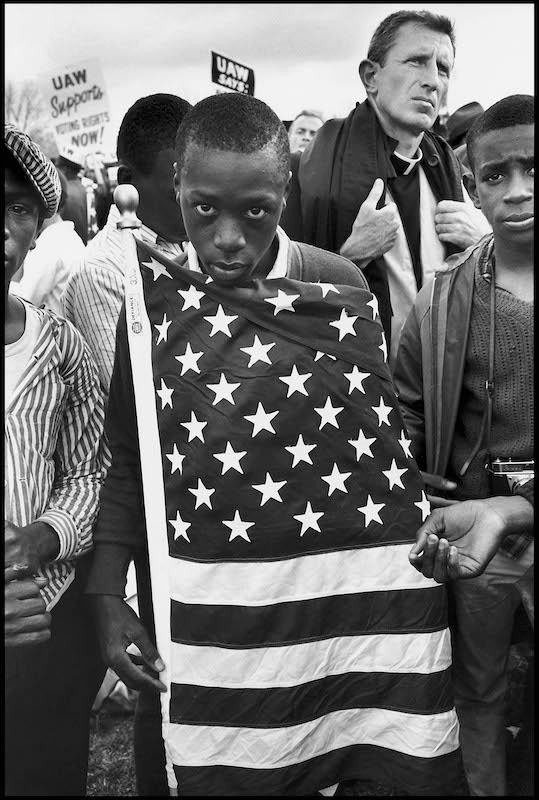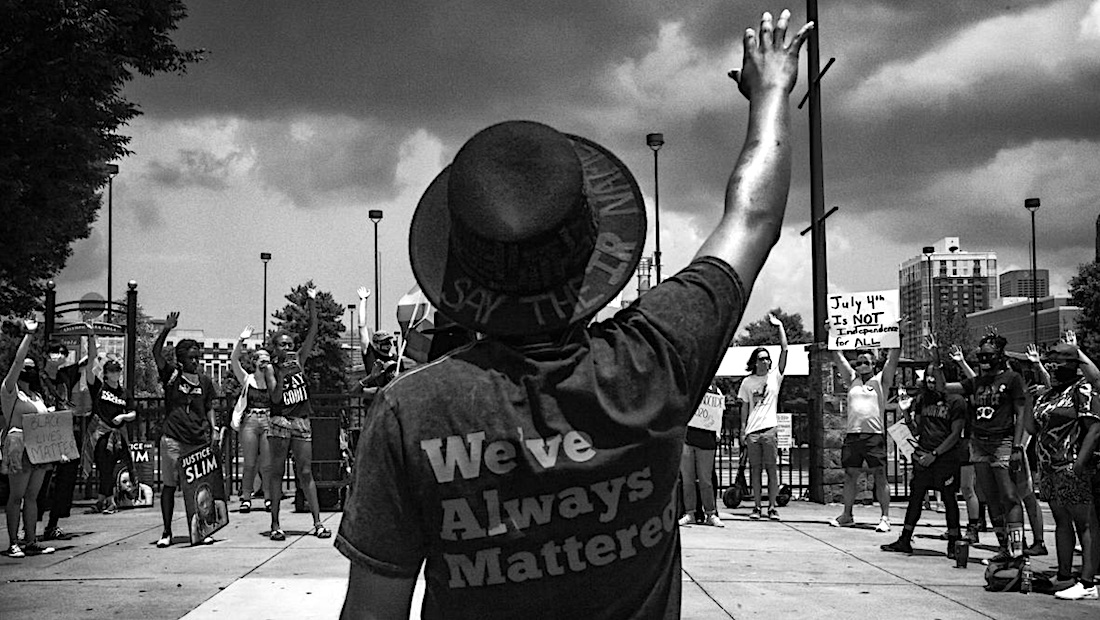America in Crisis revisits an exhibition staged in 1969 soon after Richard Nixon was elected President. Pictures taken by 18 Magnum photographers including Elliott Erwitt and Mary Ellen Mark cast a critical eye over American society and capture many of the key events that preceded Nixon’s election.
The addition of photographs taken in 2020 and 2021 bring the exhibition up to date and invite comparison between the Trump and Nixon eras. The juxtaposition is pretty devastating, since it reveals the degree to which many of the problems revealed by the first exhibition have got worse over the intervening years, racial inequality being the most glaring of them.
“How much longer can the richest nation on the planet and the wealthiest in man’s history tolerate the hunger, sickness and despair of millions of its citizens? ” asks Mitchel Levitas in the catalogue to the 1969 exhibition. “Our crisis today,” he adds, “is the clash between the nations’s traditional view of itself – the American Dream – and the harsh, discordant realities it lives within.”
 A photograph taken by Bruce Davidson in New Jersey in 1969 brilliantly sums up the discrepancy between the American Dream – that elusive promise of equality of opportunity – and the grinding poverty experienced by so many on the ground. The Statue of Liberty – symbol of freedom, hope and prosperity – can be seen in the distance through a tangle of discarded furniture and rusting car parts, framed, in other words, by the brute reality of squalor and deprivation.
A photograph taken by Bruce Davidson in New Jersey in 1969 brilliantly sums up the discrepancy between the American Dream – that elusive promise of equality of opportunity – and the grinding poverty experienced by so many on the ground. The Statue of Liberty – symbol of freedom, hope and prosperity – can be seen in the distance through a tangle of discarded furniture and rusting car parts, framed, in other words, by the brute reality of squalor and deprivation.
Has the situation improved since then? Not according to the statistics which reveal that, in 2020, 37.25 million Americans were living below the poverty line. Starting in 2014, Matt Black spent several years touring the States photographing those living on the impoverished margins. He called the project The Geography of Poverty; it began in California where, six years later, Gabriella Lurie photographed homeless families camping in tents pitched on sidewalks and under flyovers.
The exhibition is divided into chapters. The Streak of Violence reveals a society becoming ever more dangerous. The 1960s saw the assassinations of President Kennedy and Senator Robert Kennedy; since then, though, gun violence has escalated to the point where 100 Americans are shot dead every day, many of them by police armed like a militia. Philip Montgomery’s book American Mirror, 2021 includes a photo of the police patrolling a Black Lives Matter protest in Minnesota in 2021, emerging from a cloud of teargas like heavily armed ghouls.
Protest marches were a feature of both periods. Judging by the photographs, what has changed in those 30 or so years? A photograph taken in Alabama by Bruce Davidson during the Selma March of 1965 (pictured above right) shows a young black man draped in a union flag. He confronts the camera with a fixed stare of determination; exuding an aura of deep-seated fear, he looks like a supplicant. Cut to Atlanta, Georgia in 2020 and a photo by Sheila Pree Bright of protestors at a FXCK July 4 rally demanding an end to police brutality against women and the LGBTQ+ community (pictured below). A black man wearing a shirt declaring “We’ve Always Mattered” holds up his hand in salute. You can’t see his face, but his posture suggests confidence; he is demanding rather than begging. Unfortunately, we’ve seen how the new assertiveness of black protestors provokes greater repression and escalating police violence.
When I picture the anti-Vietnam war protests of 1967, what comes to mind is Marc Ribaud’s photograph of a young woman holding a flower up to the fixed bayonets of the National Guard. My choice for a comparably symbolic image of recent protests would be a photo by Leah Millis taken during a pro-Trump demo in 2017. As Donald Trump supporter Tom Condon screams abuse at anti-fascist protestors, the veins on his neck and head stand out, distended by the pounding blood of fury.
 Comparing the two pictures reveals another difference between the politics of now and then. Whereas Ribaud’s image records peaceful opposition to state violence, Millis shows something far more troubling – a deep-seated hatred both of the establishment and anyone with opposing views; in other words, the potential for civil war.
Comparing the two pictures reveals another difference between the politics of now and then. Whereas Ribaud’s image records peaceful opposition to state violence, Millis shows something far more troubling – a deep-seated hatred both of the establishment and anyone with opposing views; in other words, the potential for civil war.
Making comparisons between 1969 and 2021 may be fruitful, but looking back can also lull one into believing that, like Nixon, Trump and his supporters will get their comeuppance. That, however, would be to downplay the other very real threat of Republicans highjacking democracy and turning America into a one-party state.
The image that best conjures these terrifying prospects was taken in Washington by Leah Millis on 6 January, 2021 (main picture). Rather than homing in on the rioters storming the Capitol, she focused on the building itself. Silhouetted against the floodlights at the foot of the building one can see the army of Trump supporters. Clouds of teargas rise in the air like billowing smoke while the banners held high by the invading hordes resemble flames flickering in the night. The Capitol building looks as if it’s surrounded by a circle of fire. Democracy going up in flames. What an image !










![SEX MONEY RACE RELIGION [2016] by Gilbert and George. Installation shot of Gilbert & George 21ST CENTURY PICTURES Hayward Gallery](/sites/default/files/styles/thumbnail_125_x_125_/public/mastimages/Gilbert%20%26%20George_%2021ST%20CENTURY%20PICTURES.%20SEX%20MONEY%20RACE%20RELIGION%20%5B2016%5D.%20Photo_%20Mark%20Blower.%20Courtesy%20of%20the%20Gilbert%20%26%20George%20and%20the%20Hayward%20Gallery._0.jpg?itok=3oW-Y84i)




Add comment